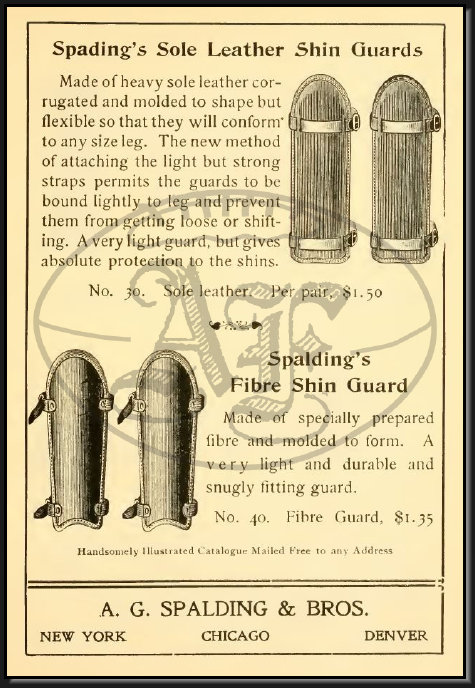






New Materials
Chris Hornung
November 27, 2017
Page 2
November 27, 2017
Page 2
Football Shinguard Evolution


By the mid-1910's, there was a clear divergence between shin guards marketed for American football and those for rugby and soccer. Cane rib guards with calf straps remained the most prominent design for football while guards with ankle protection and strapless cane or fibre guards designed to be slipped between the shin and sock were marketed as soccer and rugby guards.
In 1902, A.G. Spalding introduced two rigid shin guard models designed to "prevent contact with the sensitive shin bone rather than to attempt to soften a blow by piling on padding." The No. 30 was a corrugated, sole leather guard that was molded into the shape of the lower leg. The No. 40 (renamed the No. 30 by 1905) was similar in design, but utilized a lightweight fibre instead of sole leather. The rigid nature of these guards may explain why other manufacturers didn't offer a similar product during this timeframe. Based on period photographs, most football players continued to wear the more malleable cane rib guards through the 1910's.
Fibre & Sole Leather Guards
British Influence
By 1905, most American manufacturers had modified their football shin guard design to include the British continuous strap design, in which the straps extended across the front of the guard. Some manufacturers, such as A.J. Reach & Co. and Alex Taylor, further reinforced the strap connection point by adding leather reinforcing strips at the corners of the guard to improve durability.
A second British innovation that made its way across the Atlantic in the early 1900's was the ankle guard, or extended padding designed to protect the ankle. Designs varied but typically consisted of a U-shaped extension at the bottom of the guard which often included an elastic strap that wrapped beneath the foot to keep the guard in place during play. Ankle guard shin protectors were also marketed as soccer and field hockey guards during this time period and the style is still manufactured for those sports today.
A second British innovation that made its way across the Atlantic in the early 1900's was the ankle guard, or extended padding designed to protect the ankle. Designs varied but typically consisted of a U-shaped extension at the bottom of the guard which often included an elastic strap that wrapped beneath the foot to keep the guard in place during play. Ankle guard shin protectors were also marketed as soccer and field hockey guards during this time period and the style is still manufactured for those sports today.
A.J. Reach & Co. Fall & Winter Catalog, 1905
A.G. Spalding & Bros. Intercollegiate Football Guide, 1906
A.J. Reach & Co. Fall & Winter Catalog, 1909

A.G. Spalding & Bros. Intercollegiate Football Guide, 1902
c.1906 A.G. Spalding & Bros. No. 30 Shin Guards
c.1909 A.J. Reach & Co. No 4 Shin Guards with Continuous Strap, Ankle Protector, and Reinforcing Leather Strips
c.1910 Alex Taylor Shin Guards with Continuous Strap and Reinforcing Leather Strips
c.1905-1915 A.G. Spalding Moleskin Shin Guards with Continuous Strap Design
A.J. Reach Fall & Winter Catalog, 1916

Combined Leg, Knee and Shin Guard
In 1903, A.G. Spalding & Bros. introduced a combined leg, knee and shin guard designed by Glenn S. "Pop" Warner, then head coach of the Cornell football team. The No. C guard consisted of curved fiber shells covered in wool felt elastic straps which wrapped behind the leg. The guards also included an articulating knee cap pad. Bulky and restrictive, the No. C did not catch on with American football players and disappeared from the Spalding catalog by 1906.
A.G. Spalding & Bros. Intercollegiate Football Guide, 1906
